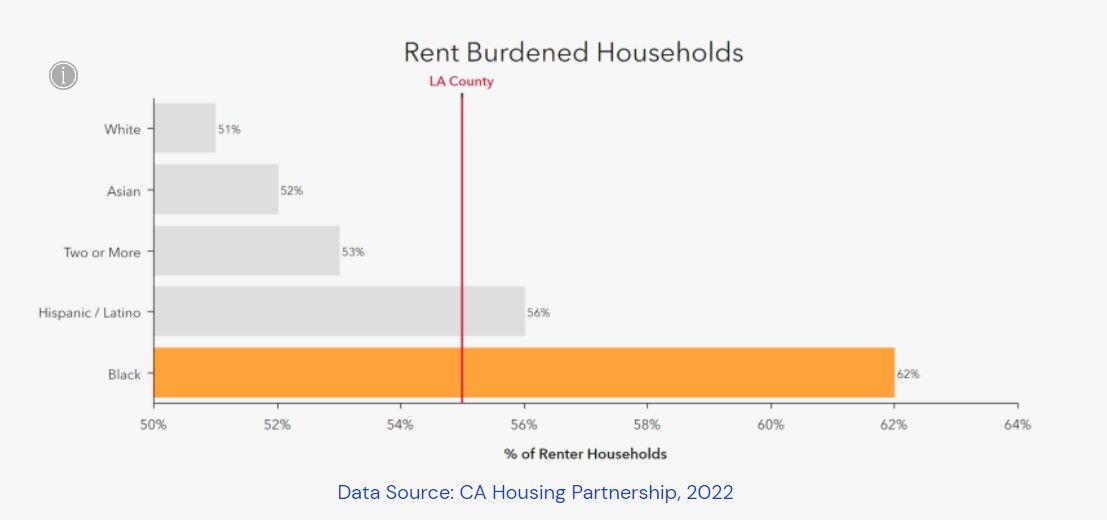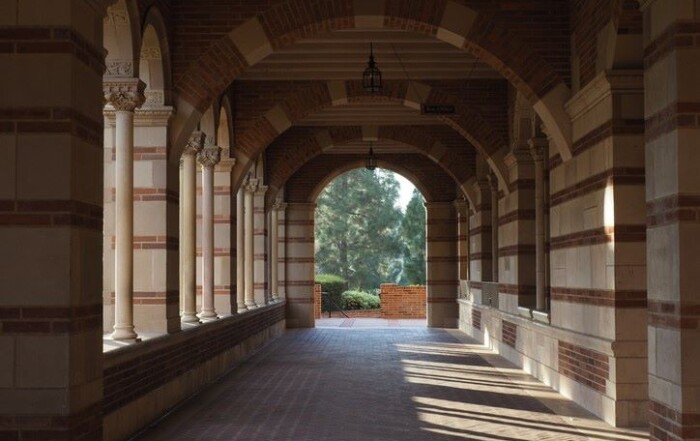An annual report released by the County’s Chief Executive Office highlighted some of the struggles that the Black community in Los Angeles has faced before and after the pandemic.
As part of its response to the George Floyd shooting and subsequent public fervor, the LA County Board of Supervisors ordered that an annual State of Black Los Angeles report be issued to provide updates on “the outcomes of Black Angelenos in the topics of health (physical and mental), education, employment, law enforcement, justice, housing, and homelessness.”
This report is twofold — serving as both a resource to understand issues in the black community while providing a tool to assess solutions and their effectiveness.
County staff with the Anti-Racism Diversity and Inclusion initiative (ARDI) — which was set into motion at the same July 20, 2020 meeting this report was — partnered with researchers from The Africana Studies Department and Mervyn M. Dymally African American Political & Economic Institute at California State University Dominguez Hills (CSUDH) and consulting firm Capacity to Impact.
Several experts were called upon to assist with the report, and the 12 experts who were interviewed met at least two of the following criteria:
- Was a member of the Los Angeles County Black community
- Had expertise in the current state of the Black community within Los Angeles County
- Had expertise in the intersection of at least one of the five domains and racial equity
Physical Health
Black Angelenos are not living as long as those from other demographics, and there seems to be a few underlying causes. The average life expectancy for a Black resident of Los Angeles is just 74.8 years, almost six years less than the next lowest racial group at 80.6 years and well below the county average of 81.3 years according to the 2020 County Health Rankings used by the report.
One apparent cause is the presence of several underlying health problems that are prevalent within the black community in Los Angeles. A 2018 County Health survey revealed 32.5 percent of adult black Angelenos are considered obese — second only to the Hispanic/Latino community at 37 percent — and 14.4 percent of black Angelenos have been diagnosed with diabetes, which is the highest mark among racial demographics in Los Angeles.
Researchers working on the report spoke with Dr. Javier Rodriguez — a scholar studying racial disparities in health and former social epidemiologist in the geriatrics division of the UCLA School of Medicine — who said that some of the issues with the black community’s physical health have to do with the community’s overall lack of awareness about it.
The report noted particular conditions like diabetes and hypertension: physical ailments that have asymptomatic periods and take time to appear. However, the problem is less about a willingness to learn and more about the distrust the black community holds for the medical establishment.
Black Angelenos are generally as covered by health insurance as other groups, but research shows many become “disengaged” with the health insurance system. Former Chief Medical Advisor to the President of the United States, Dr. Anthony Fauci, once attributed it to a “legacy of abuse,” but recent research shows that this distrust more commonly stems from unsatisfactory medical experiences they themselves have had.
Almost 40 percent of Black Angelenos have still not received a COVID-19 vaccine, while that number is just over 36 percent for the Hispanic/Latino community according to County data. Research shows that many in the Black community will look to alternate sources of information for medical issues, and research shows that many in the Black community will look to alternate sources of information for medical issues.
The first step towards curing this issue is to improve access to medical resources in low-income areas to begin repairing the broken trust of the black community.
“By first putting infrastructure in place and weaving it through communities,” the report reads, “health outcomes in the communities that struggle most from illnesses, particularly those suffering most from poverty, may be improved.”
Mental Health
The need for mental health services is “acute and growing” in the black community nationwide, according to a report from healthcare consulting firm RTI Health Advance, and Los Angeles is no exception.
Black Angelenos and other minority communities are increasingly vulnerable to psychological stressors because racial discrimination is an added stressor associated with high blood pressure and alcohol consumption. This was illustrated in a 2004 study titled Environmental Health Disparities: A Framework Integrating Psychosocial and Environmental Concepts done by Gilbert C. Gee and Devon C. Payne-Sturges.
“Because racial discrimination has profoundly shaped the experiences of racial groups, discrimination may be among the factors that shape health disparities,” the study reads.
In Los Angeles, the black community is the second most likely to both be at risk for major depression and to be currently depressed, with around 13 percent at risk and 15.3 percent currently depressed according to a 2018 survey used by the report.
This was exacerbated by the pandemic, as many of life’s difficulties that were already challenging before became overwhelming. Things like the need for caregiving, issues at home, work, and negative hospital or healthcare experiences are some of the stressors the report explains were magnified by COVID-19.
However, the Black Angeleno community bucked the nationwide trend with regard to mental health during the pandemic. While most of the country saw an increase in the number of people reporting psychological distress during the pandemic, the black community in Los Angeles was actually less likely (17.4 percent) than whites (19.1 percent) and Latinos (19.1 percent) to report having serious psychological distress in the past year. They were the only racial demographic who was less likely to report needing help after the pandemic in LA.
While psychological stress reports were down, reports of serious suicidal thoughts went up during the pandemic. It was the second leading cause for men between the ages of 15 and 24 in the black community nationwide, and 17.9 percent of Black Angelenos reported they had seriously considered committing suicide in 2021 compared to 16 percent in 2019.
When they do have psychological issues, members of the black community seek help from professionals despite their skepticism in other areas.
Housing
Housing affordability has become one of the most prominent issues in Los Angeles today, and the Black community is particularly vulnerable to issues with purchasing or renting a place to live.
In the county, the Black community has a significantly lower homeownership rate (33.5 percent) than the county average of 46 percent, according to the American Community Survey 5-Year data in 2020.
Dr. Marques Vestal, Assistant Professor of Urban Planning and Critical Black Urbanism at UCLA’s Luskin Public School of Affairs and local community activist in South L.A. attributed this in part to a widening generational age gap. Dr. Vestal noted that Black millennials are behind the previous generations financially largely due to not receiving wealth passed down from their parents or grandparents.
It is also difficult for the black community to secure the capital for homeownership for several reasons. Home prices rising have impacted everyone trying to acquire a home, but the average home value of homes owned by White Angelenos is 1.65 times greater than those of their Black counterparts, which decreases the opportunity for black families to pass generational wealth to their children.
Mortgages are still more difficult for black homeowners in LA County to obtain than average. 61 percent of mortgage applications are accepted, while the average for L.A. County is an over 65 percent acceptance rate according to 2021 data from the Home Mortgage Disclosure Act.
Black Angelenos who rent are also generally more rent burdened than peers in other demographics. 62 percent of Black renters in the community are rent burdened compared to a 55 percent average in the community, and Black renters are evicted at a much higher rate (1.6 per 100 renter households) compared to the average (1.1 per 100 renter households).
These issues go hand in hand with issues of poverty that many in the black community face, and one expert explains that tackling homelessness is more than just about solving poverty.
“We keep blaming homelessness on poverty…when poverty itself is a symptom of poor public policy,” said Tim Watkins an activist, lifelong Watts resident, and CEO and President of the Watts Labor Community Action Committee, in the report. “Unfortunately, we (society) keep treating symptoms rather than eradicating the cause of homelessness.”
Income
Wage inequality is another issue that has grown worse in recent decades despite Los Angeles’ reputation as a progressive city.
“In 1979, Los Angeles County ranked 19th out of the largest 150 regions in terms of income inequality,” the report said. “[In 2017, it ranked] 7th between New Orleans (6th) and McAllen, TX (8th),” the report reads.
This trend has disproportionately impacted the black community as well as the Hispanic/Latino community. In 2020, the Black community had the lowest average median household income at $51,259 and the Hispanic/Latino community was not far ahead at $59,837, both much below the county median of $71,358.
Having lower wages on average has impacts beyond the income it provides. Many of the lower-paying jobs people in the black community have don’t provide benefits like sick pay and employer-provided health insurance, further increasing the burden on these residents
These wage differences are also seen in the county’s unemployment demographics. Ten percent of L.A. County’s Black population over the age of 16 are unemployed, a problem exacerbated by COVID-19. Many small Black-owned businesses were forced to shut down and many workers were laid off or furloughed, causing the unemployment rate to dramatically increase among Black Angelenos.
Issues pertaining to income have cumulative effects that go beyond, one of the most important being an increased difficulty in providing kids with an adequate education.
Education
Around one in four Black students in L.A. County do not graduate high school, and only around 58.5 percent of Black students attend college or another form of secondary education according to data from the 2021 American Community Survey. This mark is much lower than their peers and one expert believes the issue lies with the system itself.
Dr. Bernadette Lucas, Chief Academic Officer for Inglewood Unified School District — which enrolls the highest percentage of African American students in the country — argues that the school system in America “was not designed for African American students in the first place.”
Lucas says that she believes interventions are needed to handle implicit biases present in the school system, which the report argues is demonstrated through Black students’ high suspension rate.
With a 5.6 percent suspension rate for Black students, they are punished by suspension 2.5 times more than White students, 3.3 times more than Latino students, and nine times more than Asian students.
This is one of the major factors that make it difficult for Black students to connect with school as a whole. Black students often experience a lower sense of belonging in their schools and have poorer relationships with their teachers according to the report, contributing to a 24.3 percent chronic absentee rate, the highest in the county.
Issues with connecting Black students have been the primary driver of the lower test scores seen from the group. Only 32.4 percent of Black 3rd grade students in the county met or exceeded testing standards according to 2019 data used in the report, while just 32.1 percent met or exceeded standards in Math.
This has led the Black community in Los Angeles to avoid one of the most clear-cut paths to a steady income: a college degree. Only around 39.5 percent of L.A. County’s Black residents get a college degree (Associate’s, Bachelor’s, or higher), compared to 62.2 percent for whites and 61.6 percent for Asians.
COVID-19 has disproportionately impacted the Black community in Los Angeles, and Dr. Lucas noted she saw “significant gaps in education levels, [students] being one to two years behind in grade work, socialization issues that led to behavioral problems, and trauma that persisted even after returning to school,” in black students following the pandemic, according to the report
She suggests that trauma assessments be done for these struggling students to ensure they are getting the proper resources to fully further their education.
Criminal Justice and Safety
While the county has focused several measures over the past several decades, Black residents are still underserved, over-prosecuted, and have more heavily skewed sentences according to the report.
This was demonstrated in the immediate aftermath of the George Floyd incident, in which 3,000 individuals were arrested during protests, mostly for non-violent offenses. After a review called on by the Los Angeles City Council, it was determined that the LAPD “grossly mishandled” the protest of Floyd’s murder.
This is not a new story for the Black community: they have had more than enough documented issues with police in the past, and more that are coming to light.
According to the report, in one year during the stop-and-frisk era, more than 700,000 individuals were stopped, according to the report. These individuals were mostly Black, and just 40 (0.0057 percent) of these stops uncovered any criminal activity and therefore had any justification.
Generally, Black residents are involved in police encounters at a disproportionate rate: only 67.8 percent of Black residents reported that they experienced “no stops by law enforcement in the last three years,” 85.7 percent of Asians, 80.6 percent of Latinos, and 75.9 percent of Whites reported “no stops” over the last three years.
Unfortunately, increased interactions with police have led to black residents being exposed to more harm from them, experts say.
“By combining “weapons of violence” with negative stereotypes and biases, police are primed for violence against Black people,” Dr. Jody Armour — Professor of Law at the University of Southern California (USC) — said in the report.
Black L.A. County residents were involved in a use-of-force incident with police that resulted in an injury at a rate of 3.9 per 100,000 people, which is over twice as much as the next racial group and 13 times more than Asians, the demographic with the least incidents.
They are also arrested and incarcerated at a higher rate than their peers. 14.1 percent of Black Angelenos reported that they have been arrested and booked at some point in their lives, compared to 13.1 percent of Whites, 8.7 percent of Latinos, and 2.5 percent of Asians who reported the same.
Black residents were over 100 times more likely than Asian residents, nearly 12 times more likely than White residents and close to 4.5 times more likely than Hispanic/Latino residents to be incarcerated in California’s prisons.
Stay informed. Sign up for The Westside Voice Newsletter
By clicking submit, you agree to share your email address with Westside Voice. We do not sell or share your information with anyone.








